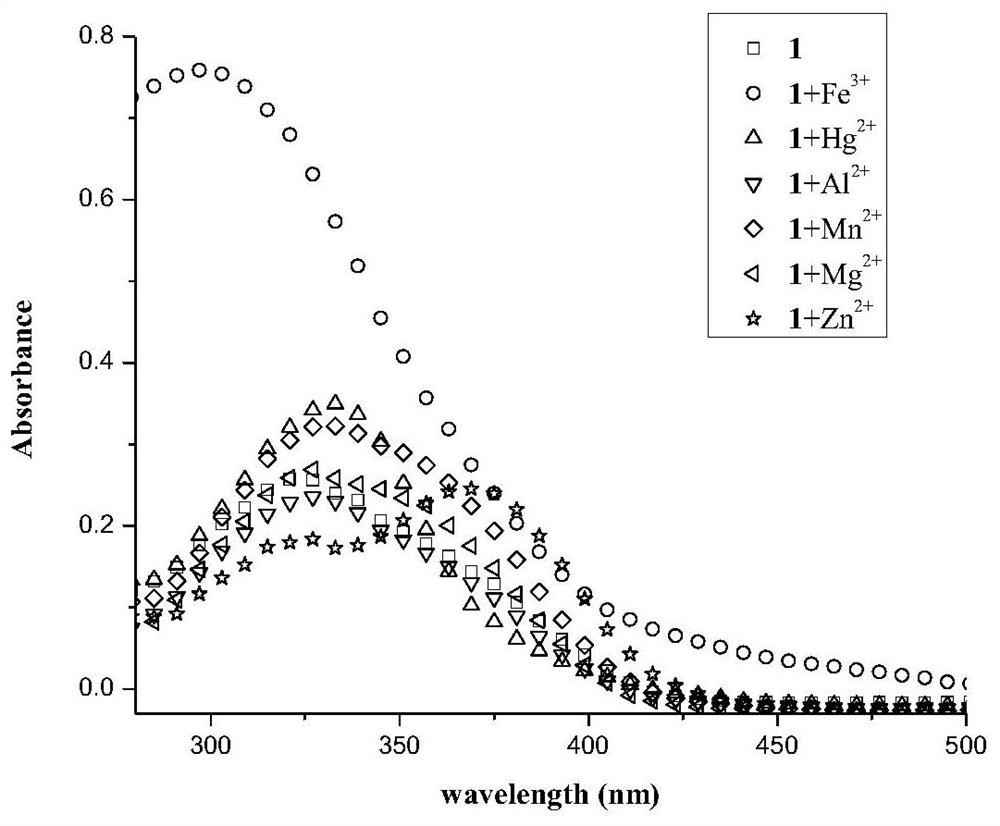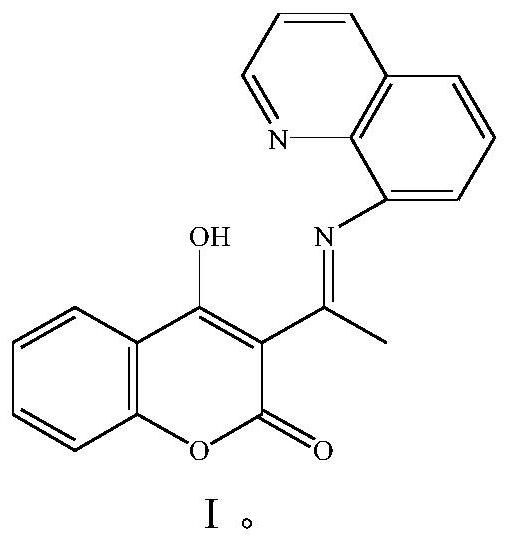A bifunctional probe for recognizing iron ions and fluorine ions and its preparation and application
A dual-function, iron ion technology, applied in the field of dual-function probes to identify iron ions and fluorine ions, to achieve the effect of simple synthesis steps, stable optical properties, and high synthesis yield
- Summary
- Abstract
- Description
- Claims
- Application Information
AI Technical Summary
Problems solved by technology
Method used
Image
Examples
Embodiment 1
[0052] Example 1: Preparation of bifunctional probes
[0053] 0.204g 3-acetyl-4-hydroxycoumarin and 0.144g 8-aminoquinoline were dissolved in 60mL methanol solution, stirred and heated to reflux for 8h; after the reaction mixture was concentrated by rotary evaporation, it was separated by column chromatography (petroleum ether / acetic acid Ethyl ester=7:3, v / v), rotary evaporation, and vacuum drying to obtain pure product 4-hydroxyl-3-[1-(quinoline-8-imino)-methyl]-chromen-2-one , yield 84.9%. NMR characterization is as follows: 1 H NMR (400MHz, CDCl 3 )δ, 9.10(d, J=4.2Hz, 1H), 8.37(d, J=8.2Hz, 1H), 8.19(d, J=8.2Hz, 1H), 7.93-7.98(m, 1H), 7.71( d,J=4.2Hz,2H),7.58-7.65(m,2H),7.27-7.32(m,2H),2.77(s,3H). 13 C NMR (400MHz, CDCl 3 )δ, 150.92, 134.07, 129.11, 128.20, 126.46, 123.64, 122.39, 116.64, 77.22, 21.67.
Embodiment 2
[0054] Example 2: Investigation of the ability of the bifunctional probe of the present invention to recognize iron ions
[0055] The probe molecule (prepared in Example 1) was formulated into 2×10 -5 M in DMF solution, and then add 10equiv of various metal ions Fe 3+ ,Hg 2+ ,Al 3+ ,Mn 2+ ,Mg 2+ ,Zn 2+ , measure the UV-Vis absorption spectrum of the blank solution and the mixed solution, the results are as follows figure 1 shown. It was found experimentally that only by adding Fe 3+ , the original probe molecule's maximum absorption peak at 324nm had a significant blue shift to 296nm (Δλ=28nm), and the maximum absorption intensity also increased from 0.26 to 0.76 (2.9 times). However, other metal ions do not change significantly, indicating that the bifunctional probe molecule of the present invention can selectively recognize iron ions.
Embodiment 3
[0056] Example 3: Investigation of the ability of the bifunctional probe of the present invention to recognize fluoride ions
[0057] The probe molecules and iron ions (Fe 3+ ) at a molar ratio of 1:1 to form a probe-iron ion complex, and the probe-iron ion complex was prepared as 2×10 -5 DMF solution of M, add various anions F - , Cl - , Br - , HSO 4 - , measure the UV-Vis absorption spectrum of the solution, the results are as follows figure 2 As shown, it was found that when 10 equiv of fluoride ions were added, the absorption intensity decreased significantly, which was at the same level as the recognition intensity of the probe molecule, which indicated that the probe-iron ion complex could further selectively recognize fluoride ions.
PUM
 Login to View More
Login to View More Abstract
Description
Claims
Application Information
 Login to View More
Login to View More - R&D
- Intellectual Property
- Life Sciences
- Materials
- Tech Scout
- Unparalleled Data Quality
- Higher Quality Content
- 60% Fewer Hallucinations
Browse by: Latest US Patents, China's latest patents, Technical Efficacy Thesaurus, Application Domain, Technology Topic, Popular Technical Reports.
© 2025 PatSnap. All rights reserved.Legal|Privacy policy|Modern Slavery Act Transparency Statement|Sitemap|About US| Contact US: help@patsnap.com



